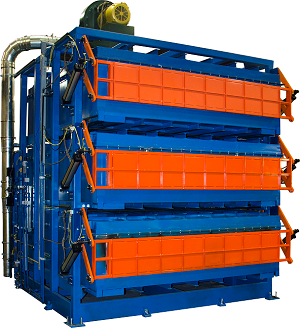
Saving Stacks with Stackable Hot Stamp Furnaces
Posted on March 08, 2021 in Blog

Hot stamping is a manufacturing process that involves forming complex automobile parts in a single step pattern. It creates lighter and stronger components which improves overall safety in modern vehicles. The process of hot stamping for the automotive industry creates a multi-component part that is stronger than a similar welded component.
Hot stamping is often the chosen method because it efficiently produces lightweight automobile parts. Lighter components equal better gas mileage which results in significant savings to the customer in fuel costs over the life of the vehicle. As federal fuel economy standards increase, the demand for lightweight steel parts in vehicles will continue to grow. Hot stamp furnaces also have the ability to process multiple parts, shapes, and thicknesses and can be fully automated using mechanical or robotic devices.
3 Advantages of Stackable Hot Stamp Furnaces
Hot stamping furnaces are available in both continuous and batch style designs. Continuous designs take up a significant amount of floor space in factories and do not provide the flexibility to run different components simultaneously. Their maintenance cost is higher than batch style designs due to roller replacement and radiant tubes. The limitations and costs of the continuous style hot stamp furnace led to the innovation of the stackable batch style design. The advantages of the stackable design expand a manufacturer’s production capabilities and saves costs. The top 3 advantages of choosing this design are highlighted below:
Compact Footprint Saves on Valuable Floor Space
Everyone knows that real estate is costly which means floor space is a key consideration when bringing in new equipment. Saving precious square footage is an important benefit that the stackable design provides. Multiple chambers can be stacked up so manufacturers are able to meet their production requirements by going up instead of using the large area of floorspace that a comparable continuous unit would require.
Independent Chambers Increase Production Capabilities
With the option to stack chambers, customers are provided with unmatched versatility in part production. Each chamber operates independently from the others so multiple vehicle parts can be processed at the same time. In addition to that, each chamber can be designed with 3 heating zones further expanding the production capabilities. Batch units can also be used as prototype testing for both aluminum and steel parts. Each chamber temperature uniformity can be customized in batch furnaces for complex part shape and variable thicknesses.
Maintenance Flexibility Reduces Unproductive Downtime
Finally, because each chamber is independent from one another, repairs can be made to one or two of the chambers without having to shut down the entire furnace. Individual chambers or the entire furnace can be shut down because of the quick heat-up rates. This minimizes lost production during downtime for maintenance and allows manufacturers to continue to run parts in the operating chambers.
The Hot Stamping Solution for the Future
The ability to produce lighter vehicle parts is key to a more sustainable and fuel-efficient automobile industry. The stackable hot stamp furnace design exemplifies how technological innovation goes hand in hand with customer and industry demands.
Innovation and efficiency are top priorities at Lindberg/MPH, which is why our stackable hot stamp furnaces are compatible with robotic or mechanical loading/unloading devices. Designs are available to meet any type of robotic loader or other end of arm tooling. No cooling water is required for the entire system, which also saves on costs and provides ease of installation.
To find out more about Lindberg/MPH hot stamp furnaces and other heat treat and melting solutions, click here.

